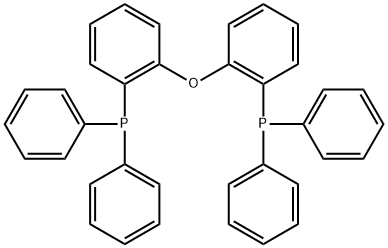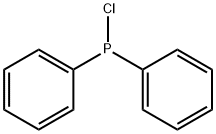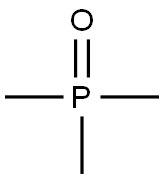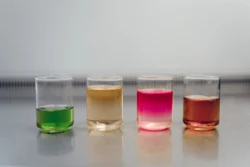4,5-Bis(diphenylphosphino)-9,9-dimethylxanthene
Synonym(s):4,5-Bis(diphenylphosphino)-9,9-dimethylxanthene
- CAS NO.:161265-03-8
- Empirical Formula: C39H32OP2
- Molecular Weight: 578.62
- MDL number: MFCD00233866
- EINECS: 605-249-4
- SAFETY DATA SHEET (SDS)
- Update Date: 2025-07-24 18:13:45

What is 4,5-Bis(diphenylphosphino)-9,9-dimethylxanthene?
Description
XantPhos is a bidentate bis-phosphine ligand with a wide bite angle. XantPhos is commonly used as a ligand in palladium catalyzed cross-coupling reactions such as Buchwald reactions.
Chemical properties
White to light yellow crystals
The Uses of 4,5-Bis(diphenylphosphino)-9,9-dimethylxanthene
suzuki reaction
The Uses of 4,5-Bis(diphenylphosphino)-9,9-dimethylxanthene
4,5-Bis(diphenylphosphino)-9, 9-dimethylxanthene is used as a bidentate ligand, which finds application in hydroformylation of alkenes.
The Uses of 4,5-Bis(diphenylphosphino)-9,9-dimethylxanthene
1,1'-(9,9-Dimethyl-9H-xanthene-4,5-diyl)bis[1,1-diphenyl-phosphine is an organophosphorus compound derived from the heterocycle xanthene. It is used as a bidentate ligand and is noteworthy for having a particularly wide bite angle. Such ligands are useful in the hydroformylation of alkenes.
Reactions
- Ligand used for the hydroformylation of alkenes.
- Ligand used in the intermolecular coupling of amides and hydrazones with aryl halides.
- Ligand used in the intermolecular coupling of amides with aryl halides or triflates.
- Ligand used in the coupling of heteroarylamines and aryl halides.
- Ligand used in the hydrophosphinylation of alkenes and alkynes.
- Ligand used for the Au(I)-catalyzed dehydrogenative silation of alcohols.
- Ligand used for the sulfinylation of aryl iodides.
- Ligand used for the Pd-catalyzed carbonylation reaction of aryl bromides and amines.
- Ligand used for the Ni-cataltzed alkynylcyanation of alkynes.
- Ligand used for the Pd-catalyzed N-arylation of 3-amino-1H-pyrazole.
- Ligand used for the Rh-catalyzed dehydrogenation borylation of cyclic alkenes.
- Ligand used for the Pd-catalyzed intermolecular coupling of H-Phosphonate diesters with benzyl halides.
- Ligand used for the Pd-catalyzed one pot synthesis of 4-aryl-1H-1,2,3-triazoles.
- Ligand used for the Pd-catalyzed intermolecular addition of formamides to alkynes.
- Ligand used for the Pd-catalyzed decarboxylative couplings of 2-(2-azaaryl)acetates with aryl halides and triflates.
- Ligand used for the Pd-catalyzed benzylic arylation of 2-methyl azaarenes
- Ligand used for the Pd-catalyzed α-arylation of heteroaromatic ketones.
- Ligand used for the Pd-catalyzed direct alkynlation of both azoles and azolines.
- Ligand used for the Cu-catalyzed intermolecular coupling of alkynes with aryl iodides.
- Ligand used for the Pd-catalyzed ene-type reaction of aldehydes with 1,3-diene.
- Ligand used for the Ru-catalyzed intermolecular addition of 2-phenylbenzoic acid onto unactivated olefins.
- Ligand used for the Pd/Cu-catalyzed direct arylation of heteroarenes.
- Ligand used for the Pd-catalyzed reaction of propargyl-substituted malonate esters with aryl halides.
- Ligand used for the Pd-catalyzed decarboxylative coupling of tertiary cyanoacetate salts with aryl halides and triflates.
- Ligand used for the Pd-catalyzed hydroesterification of alkynes.
- Ligand used for the Cu-catalyzed arylation of arylboronic acids with aldehydes.
- Ligand used for the Ru-catalyzed oxidative synthesis of heterocycles from alcohols.
- Ligand used for the Rh-catalyzed borylation of nitriles.
- Ligand used in the Pd-catalyzed α-arylation of benzylic phosphine oxides.
- Ligand used in the Pd-Catalyzed Oxidative Coupling of Enamides and Alkynes.
- Ligand used in the Pd-catalyzed difunctionalization of enol ethers to amino acetals with aminals and alcohols.
- Ligand used in the Pd-catalyzed alkoxycarbonylation of α-chloroketones.






Preparation
A mixture of the chloride (25 g, 168 mmol), the amine (40 g, 168 mmol), Pd(OAc)2 (1.5 g, 6.72 mmol), (+-) BINAP (4.18 g, 6.72 mmol), and Cs2CO3 (76.7 g, 235.2 mmol) in toluene (800 mL) was stirred at 90 C under N2 for 23 h. The mixture was filtered through a pad of celite and washed with EtOAc. The filtrate was concentrated in vacuo and purified by silica gel flash chromatography (1:5 EtOAc/petroleum ether) to provide the product as a red solid. [22.4 g, 37%]
Properties of 4,5-Bis(diphenylphosphino)-9,9-dimethylxanthene
| Melting point: | 224-228 °C(lit.) |
| Boiling point: | 665.7±55.0 °C(Predicted) |
| Flash point: | 450℃ |
| storage temp. | Keep in dark place,Sealed in dry,Room Temperature |
| solubility | Soluble in organic solvents. |
| appearance | Colorless solid |
| form | Crystals |
| color | White to light yellow |
| CAS DataBase Reference | 161265-03-8(CAS DataBase Reference) |
Safety information for 4,5-Bis(diphenylphosphino)-9,9-dimethylxanthene
| Signal word | Warning |
| Pictogram(s) |
 Exclamation Mark Irritant GHS07 |
| GHS Hazard Statements |
H315:Skin corrosion/irritation H319:Serious eye damage/eye irritation H335:Specific target organ toxicity, single exposure;Respiratory tract irritation |
| Precautionary Statement Codes |
P261:Avoid breathing dust/fume/gas/mist/vapours/spray. P264:Wash hands thoroughly after handling. P264:Wash skin thouroughly after handling. P271:Use only outdoors or in a well-ventilated area. P280:Wear protective gloves/protective clothing/eye protection/face protection. P302+P352:IF ON SKIN: wash with plenty of soap and water. P305+P351+P338:IF IN EYES: Rinse cautiously with water for several minutes. Remove contact lenses, if present and easy to do. Continuerinsing. |
Computed Descriptors for 4,5-Bis(diphenylphosphino)-9,9-dimethylxanthene
| InChIKey | CXNIUSPIQKWYAI-UHFFFAOYSA-N |
4,5-Bis(diphenylphosphino)-9,9-dimethylxanthene manufacturer
JSK Chemicals
BTC Pharmaceuticals Technology India
New Products
Indole Methyl Resin tert-butyl 9-methoxy-3-azaspiro[5.5]undecane-3-carboxylate Boc-His(Boc)-OH 2-CTC Resin 4-Chloro-7-tosy1-7Hpyrrolo[2,3-d]pyrimidine 5,7-Dibromo-1H-indole 2,5-dichloro-N-hydroxy-4,6-dimethylpyridine-3-carboximidamide 2,2-Dimethoxy-7-azaspiro[3.5]nonane hydrochloride 4-chloromethyl-5-methyl-1,3-dioxol-2-one (DMDO-Cl) R-2-BENZYLOXY PROPIONIC ACID 1,1’-CARBONYLDIIMIDAZOLE 1,1’-CARBONYLDI (1,2-4 TRIAZOLE) N-METHYL INDAZOLE-3-CARBOXYLIC ACID 4-((2-hydroxyethyl)thio)benzoic acid 1-(TERT-BUTOXYCARBONYL)-2-PYRROLIDINONE Methyl 6-methylnicotinate 3-Pyridineacrylic acid tert-Butyl carbazate TETRAHYDRO-2H-PYRAN-3-OL 2-((4-morpholinophenylamino) (methylthio) methylene) malononitrile 3-(4-morpholinophenylamino)-5-amino-1H-pyrazole-4-carbonitrile 2,4-dihydroxybenzaldehyde 1,3-Diethyl-1,3-Diphenylurea Methyl 2-methylquinoline-6-carboxylateRelated products of tetrahydrofuran








You may like
-
 Xantphos, 97% 161265-03-8 99%View Details
Xantphos, 97% 161265-03-8 99%View Details
161265-03-8 -
 XantPhos (4,5-Bis(Diphenylphosphino)-9,9-Dimethylxanthine) extrapure CAS 161265-03-8View Details
XantPhos (4,5-Bis(Diphenylphosphino)-9,9-Dimethylxanthine) extrapure CAS 161265-03-8View Details
161265-03-8 -
 4,5-Bis(diphenylphosphino)-9,9-dimethylxanthene CAS 161265-03-8View Details
4,5-Bis(diphenylphosphino)-9,9-dimethylxanthene CAS 161265-03-8View Details
161265-03-8 -
 Xantphos CAS 161265-03-8View Details
Xantphos CAS 161265-03-8View Details
161265-03-8 -
 Xantphos CAS 161265-03-8View Details
Xantphos CAS 161265-03-8View Details
161265-03-8 -
 Xantphos ChemBeads CAS 161265-03-8View Details
Xantphos ChemBeads CAS 161265-03-8View Details
161265-03-8 -
 4,5-Bis(Diphenylphosphino)-9,9-Dimethylxanthene Cas:161265-03-8View Details
4,5-Bis(Diphenylphosphino)-9,9-Dimethylxanthene Cas:161265-03-8View Details
161265-03-8 -
 4,5-Bis(Diphenylphosphino)-9,9-DimethylxantheneView Details
4,5-Bis(Diphenylphosphino)-9,9-DimethylxantheneView Details
161265-03-8
